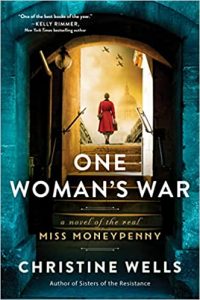Two Extraordinary Women Who Inspired One Woman’s War
Two Extraordinary Women Who Inspired One Woman’s War
by Christine Wells
 I saw my first James Bond film at the age of seven. We were having a family holiday in Sydney, Australia, and Mum left my brother and me with Dad while she enjoyed a well-earned day to herself. Instead of taking us to the museum or some other culturally enriching experience my mother would have approved of, Dad took us to see the latest James Bond film, For Your Eyes Only.
I saw my first James Bond film at the age of seven. We were having a family holiday in Sydney, Australia, and Mum left my brother and me with Dad while she enjoyed a well-earned day to herself. Instead of taking us to the museum or some other culturally enriching experience my mother would have approved of, Dad took us to see the latest James Bond film, For Your Eyes Only.
When we came out of the theater, my father asked me whether I enjoyed the movie, I said, “Well, how could I? My heart was in my mouth the whole time!” My mother was not pleased.
So began my lifelong fascination with spy stories—from the more cerebral, ambiguous novels by John le Carré and Graham Greene to edge-of-the-seat television dramas like The Americans and Homeland.
I became less interested in the character of James Bond than in his creator, Ian Fleming. Commander Ian Fleming was personal assistant to Admiral Godfrey, the Director of Naval Intelligence during World War II, a position with heavy responsibility for planning operations, liaising with various committees and interested parties to carry these into effect. His wartime experience in Naval Intelligence clearly informed his James Bond series.
In recent years, I have written novels inspired by the real women who undertook dangerous covert missions for Britain and France during the Second World War—women like Noor Inayat Khan, Violette Szabo, and Catherine Dior. While researching my previous book, Sisters of the Resistance, I came across an old newspaper article that listed several real women who might have been the inspiration for the character of Miss Moneypenny in the James Bond novels. To me, only one woman perfectly fit the bill. Her name was Victoire Evelyn Patricia Bennett—“Paddy” to her friends.
Sorbonne-educated, intelligent, forthright, attractive, a young woman who suffered neither fools nor flirtation, twenty-year-old Paddy Bennett worked for Ian Fleming at British Naval Intelligence, as well as six other offices who inhabited the famous “Room 39.” Paddy later left the service to get married, as many women did in those days, but she was subsequently recruited to take part in one of the most eccentric and effective intelligence operations of all time: Operation Mincemeat.
Since writing One Woman’s War, a movie about the operation starring the “two Mr. Darcy’s”, Colin Firth and Matthew Macfadyen, has come out. It’s an extraordinary tale of a practical joke on the Germans that had serious and significant impact on the war effort. However, in the movie, Paddy Bennett isn’t mentioned at all.
Nor is another real spy whose wartime adventures as a double agent inspired me to draw her into my novel as an antagonist for Paddy.
A completely different style of woman from Paddy, Friedl Stöttinger was Austrian by birth, but she worked as a double agent for Britain during the Second World War.
Cosmopolitan, sophisticated, and sexy, Friedl had a somewhat checkered past. From her MI-5 file we know that she married an Orthodox Jew and left Austria for Palestine in the 1930s but later divorced and left the country. She went on to sing in nightclubs around Europe before relocating to England, where her sister, Lisi, also a nightclub performer, had settled. Lisi had married a member of the British Establishment, who happened to be the brother of Secret Service chief, Stewart Menzies.
Both young women seem to have had the entrée into high society. Whether this was due to family connections—their father was a high-ranking Nazi—or due to their personal charms and abilities, is unclear.
After Germany annexed Austria and Britain declared war, Friedl became an enemy alien, liable to be deported or interned. Preferring to escape both fates, Friedl made contact with MI-5 through her brother-in-law and offered to spy for Britain.
First, she masqueraded as a Nazi sympathiser and reported back on fifth column activity in England, eventually giving evidence against the Russian spy, Anna Wolkoff, who had been passing intelligence gleaned from the American embassy in London to the Italians.
Later in the war, Friedl was recruited to be part of Duško Popov’s spy circuit, in which she posed as a loyal German passing information to the Nazis via a post box “drop” in Lisbon, Portugal. Popov is thought to have been one of the spies on whom James Bond is modelled—debonair, quick-witted and resourceful, a playboy and gambler who seemed to relish risking his life in a battle of wits against the Nazis.
Popov had convinced the Germans he could launder their money so that their foreign informants could be paid in the correct currency. In fact, the German funds were handed over to the British secret service, along with valuable intelligence.
Friedl and Popov were reported to have embarked on a torrid affair while spying for Britain. Given Popov’s peripheral involvement in Operation Mincemeat and his activity in Spain and Portugal, I decided to draw Friedl into the story and create a new conflict for her, which would see her face the dilemma over whether to obey her German masters and place Operation Mincemeat in jeopardy or remain loyal to the British cause.
So while James Bond is the quintessential masculine hero, One Woman’s War is about the women who surrounded Bond’s creator, their resourcefulness and courage, and their contribution towards winning the war.
—
Christine Wells writes historical fiction featuring strong, fascinating women. From early childhood, she drank in her father’s tales of kings and queens and epic struggles for power across the globe, and has been a keen student of history ever since. She began her first novel while working as a corporate lawyer, and has gone on to write about periods ranging from Georgian England to World War II France. She loves dogs, the beach and antiquing on Instagram and lives with her family in Brisbane, Australia.
Find out more about Christine on her website https://christine-wells.com/
ONE WOMAN’S WAR
From the author of Sisters of the Resistance comes the story of WWII British Naval Intelligence officer Victoire Bennett, the real-life inspiration for the James Bond character Miss Moneypenny, whose international covert operation is put in jeopardy when a volatile socialite and Austrian double agent threatens to expose the mission to German High Command.
 World War II London: When Victoire “Paddy” Bennett first walks into the Admiralty’s Room 39, home to the Intelligence Division, all the bright and lively young woman expects is a secretarial position to the charismatic Commander Ian Fleming. But soon her job is so much more, and when Fleming proposes a daring plot to deceive the Germans about Allied invasion plans he requests the newlywed Paddy’s help. She jumps at the chance to work as an agent in the field, even after the operation begins to affect her marriage. But could doing her duty for King and country come at too great a cost?
World War II London: When Victoire “Paddy” Bennett first walks into the Admiralty’s Room 39, home to the Intelligence Division, all the bright and lively young woman expects is a secretarial position to the charismatic Commander Ian Fleming. But soon her job is so much more, and when Fleming proposes a daring plot to deceive the Germans about Allied invasion plans he requests the newlywed Paddy’s help. She jumps at the chance to work as an agent in the field, even after the operation begins to affect her marriage. But could doing her duty for King and country come at too great a cost?
Socialite Friedl Stöttinger is a beautiful Austrian double agent determined to survive in wartime England, which means working for MI-5, investigating fifth column activity among the British elite at parties and nightclubs. But Friedl has a secret—some years before, she agreed to work for German Intelligence and spy on the British.
When her handler at MI-5 proposes that she work with Serbian agent, Duško Popov, Friedl falls hopelessly in love with the dashing spy. And when her intelligence work becomes fraught with danger, she must choose whether to remain loyal to the British and risk torture and execution by the Nazis, or betray thousands of men to their deaths.
Soon, the lives of these two extraordinarily brave women will collide, as each travels down a road of deception and danger leading to one of the greatest battles of World War II.
BUY HERE
Category: On Writing























